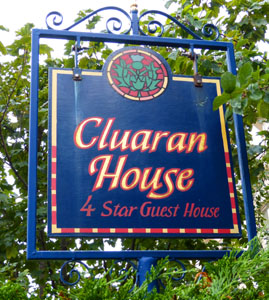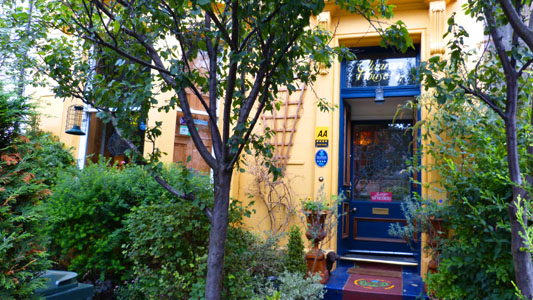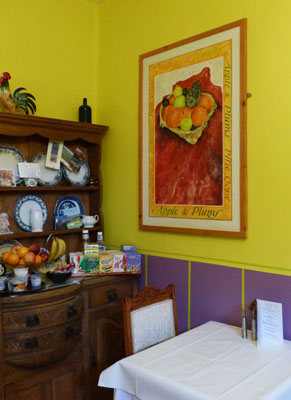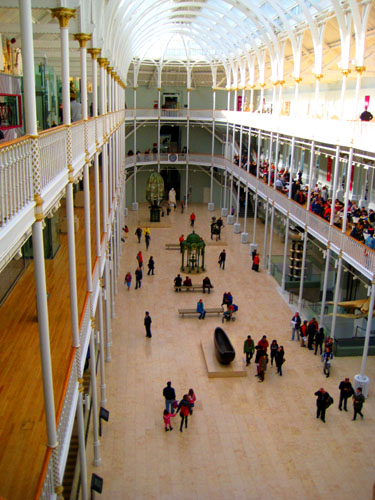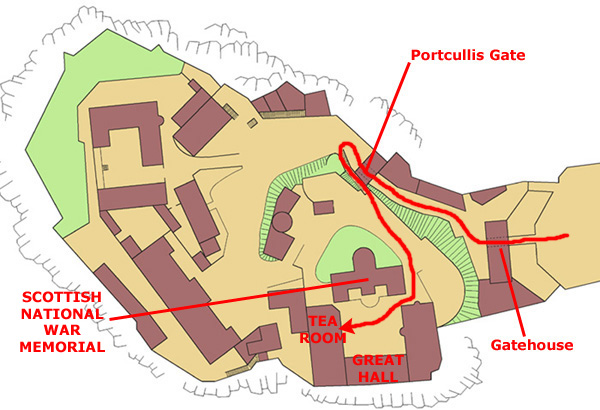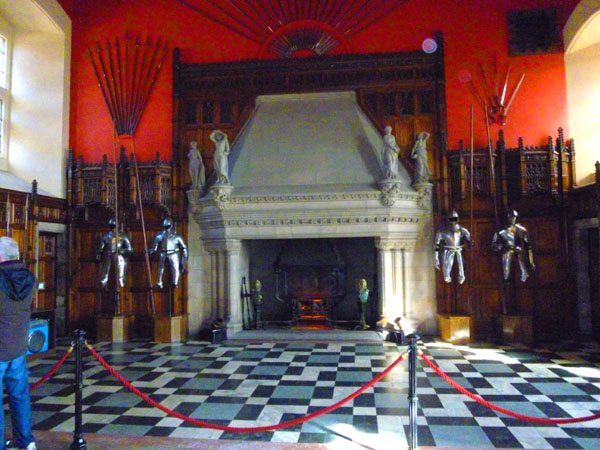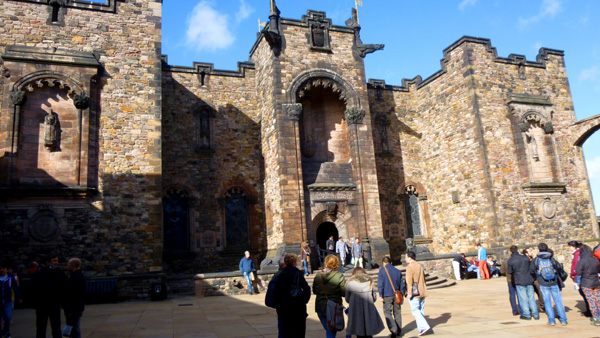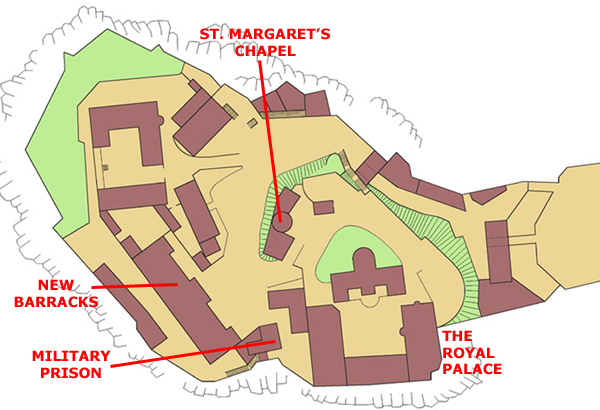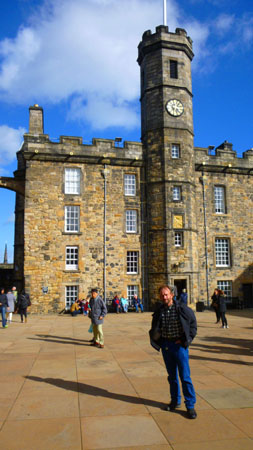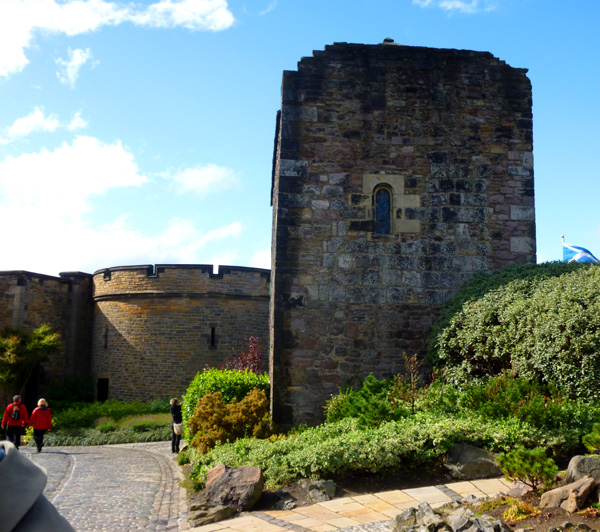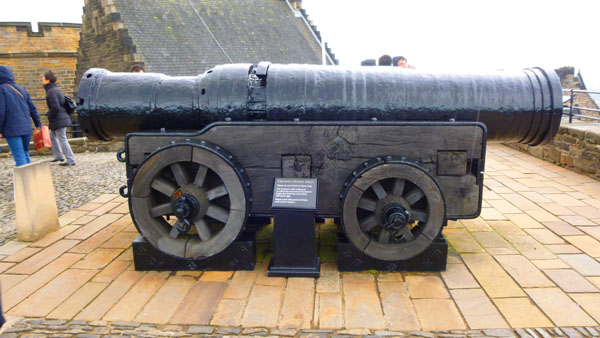
A Unique Bed & Breakfast In the Heart of San Antonio's Historic District
Today was one of the few days on our trip on which the weather was not good; it was raining and chilly in the morning, although it cleared up for a while in midday before some scattered showers late in the afternoon. Most of the group wanted to go to the Scottish Royal Museum, but museums aren't really my thing, so since it was raining, I stayed at the Guest House to work on our daily email missive. I also consolidated all the pictures we'd taken in and around the guest house, and I'll introduce you to it in the first of this page's sections.
The Cluaran Guest House
The house was renovated when our hosts first moved there in 1999, and is now decorated with bright harmonious colors that complement an interior that belies its location in a row of houses through its seemingly bright, airy and spacious interior. Just like my house in Dallas, there is a lot of natural light. Many original features have been restored to something of their former glory; examples are the
stained glass panel
in the front door and the original wood floors. Cornices, wooden shutters,
mouldings and other accents
have been restored to try to recapture as much of the skilled craftsmanship of the period as possible.
All of the bedrooms are have ensuite baths except the single that Guy occupied; its bath was just across the stairway landing. As with all the places we stayed, there was convenient Internet access that allowed us to send out our daily emails. The breakfasts were quite good, although unlike the bed and breakfasts that we have stayed in within the US, breakfasts were cooked to order, with
a little buffet
for the cold items like fruit and cereal. We were occupying almost all the rooms, so it wasn't difficult to get
a large table in the breakfast room
to accommodate all of us.
Below are clickable thumbnails for some additional photos taken in the breakfast room:
I didn't make a movie wandering around Cluaran Guest House, but we did take some pictures of the public areas and a couple of the room that we occupied. Just inside the front door, there is a welcome hall, whose main feature is a beautiful old staircase.
I really liked the stairway, with its curves at both the bottom and the top. Of all the pictures we took of it, I've selected a couple more to include here- one
looking up
and one
looking down.
The other rooms we took pictures of were the living room (the large public space) and our own room.
Below are clickable thumbnails for two pictures that Fred took in our room at Cluaran House:
Well, that's it for the Cluaran Guest House. Now let's go see more of Edinburgh.
The Royal Museum of Scotland
Since I was not along, I can't say much about many of the photos that Fred took, so I will simply include the best of them here. You can use the clickable thumbnails below to have a look:
Three of the object that Fred photographed had accompanying signs, so for these three, you can see both the picture and the sign using the links below:
Statue of James Watt
(read sign
here)
As expected, the weather began to clear right after lunch, so after I sent out the daily email and did some picture work, I headed out to catch up with the group at Edinburgh Castle.
Edinburgh Castle
The historic fortress on Castle Rock dominates the city of Edinburgh; archaeologists have established human occupation of the rock since at least AD 200, and there has been a royal castle on the rock since at least the reign of David I in the 12th century. After the Union of the Crowns in 1603, the castle's residential role declined, and by the 17th century was principally a military garrison. It is one of Scotland's most important sites, involved in many historical conflicts from the Wars of Scottish Independence in the 14th century to the Jacobite Rising of 1745. It has been besieged, both successfully and unsuccessfully, on several occasions. As befits such an important site, restoration and upkeep are continual.
Few of the present buildings pre-date the Lang Siege of the 16th century, when the medieval defences were largely destroyed by artillery bombardment. The most notable exceptions are St Margaret's Chapel (early 1100s and the oldest building in Edinburgh), the Royal Palace, and the early-16th-century Great Hall. The interiors, of course, have been altered over the centuries. The castle also houses the Scottish regalia (the "Honors of Scotland") and is the site of the Scottish National War Memorial and the National War Museum of Scotland. The British Army is still responsible for some parts of the castle, although its presence is now largely ceremonial and administrative. Some of the castle buildings house regimental museums which contribute to its presentation as a tourist attraction.
The castle is the backdrop to
the Edinburgh Military Tattoo
during the annual Edinburgh International Festival (the bleacher-like constructions around the plaza are from that festival) and the castle has become a recognizable symbol of Edinburgh and of Scotland.
I followed the signs to the tea room, and there I found Guy, Prudence and Fred. They were just finishing up with a light lunch and after Nancy and Karl returned from the Castle store, we made some plans to look at as much of the complex as we could. Below are clickable thumbnails for some of the pictures taken in the Tea Room:
Done with a bit of lunch, we sat by the window of the tea room looking out onto
Crown Square
and planning where we wanted to go next. Our decision was to go to the building next door- the Great Hall.
The Great Hall
Following Oliver Cromwell's seizure of the castle in 1650, the Great Hall was converted into a barracks for his troops; and in 1737 it was subdivided into three storeys to house 312 soldiers. This use is emphasized through
the display of armament
around the walls. Following the construction of the New Barracks in the 1790s, it became a military hospital until 1897. It was then restored by Hippolyte Blanc in line with contemporary ideas of medieval architecture. The Great Hall is still occasionally used for ceremonial occasions (and as the setting for British television shows).
Across Crown Square from the Great Hall was the Scottish National War Memorial, and that was our next stop.
Scottish National War Memorial
The memorial commemorates Scottish soldiers, and those serving with Scottish regiments, who died in the two world wars and in more recent conflicts. Upon the altar within the Shrine, placed upon the highest point of the Castle Rock, is a sealed casket containing Rolls of Honor which list over 147,000 names of those soldiers killed in the First World War. After the Second World War, another 50,000 names were inscribed on Rolls of Honor held within the Hall, and further names continue to be added there.
Arrayed around the inside of the memorial, on shelves allowing visitors access to them, are copies of these Rolls of Honor. They are organized by conflict and by military organization; there is no one master list available (or accessible online yet). Photography was not allowed inside, so we had only the opportunity to take pictures outside. The picture above right is of course the view from Crown Square; Fred also took a picture of
me at the entrance.
A little later on in the afternoon, we happened to be around on the other side of the building that houses the memorial, and we took a couple of pictures from that angle. You can see them
here
and
here.
When we were done there, we walked back across the square and around the building housing the Tea Room to visit the military prison and the new barracks.
The last building we went inside was St. Margaret's Chapel, a little ways around to the north. After that, we just wandered around the battlements for a while taking pictures.
The Royal Palace
On this same floor there is a small room, known as the Birth Chamber or Mary Room, where James VI was born to Mary, Queen of Scots, in June 1566. The commemorative painted ceiling and other decoration were added in 1617. This room was dark and hard to photograph, so I made a movie instead; you can watch it with the player below:
On the first floor is the vaulted Crown Room, built in 1615 to house the Honours of Scotland: the crown, the sceptre and the sword of state. The Stone of Scone, upon which the monarchs of Scotland were traditionally crowned, has been kept in the Crown Room since its return to Scotland in 1996. To the south of the palace is the Register House, built in the 1540s to accommodate state archives. We did tour these rooms, but photography was only allowed in the first few rooms where there were exhibits relating to the items on display. You can see a couple of pictures of the exhibits
here
and
here.
There were also two interesting signs having to do with the Scottish Crown, and I have enlarged them and put them in the two scrollable windows below:
Military Buildings
Clickable thumbnails for pictures taken in
St. Margaret's Chapel
The chapel fell into disuse at the Protestant Reformation, and it became a storeroom. When the antiquarian Sir Daniel Wilson realized the significance of
the chapel building,
his publicity efforts (and the support of Queen Victoria) led to the removal of the garrison chapel and the restoration of St. Margaret's Chapel in 1851–1852. The barrel-vault over the nave was added at this time and the stained glass was installed in 1922. In 1929 further work was carried out to bring the chapel back into use, and the restored and refurnished chapel was dedicated on 16 March 1934.
The small irregular stone building has some similarity to earlier Scottish and Irish Celtic chapels. The rectangular structure is ten feet wide inside, and the nave is 16 feet long. A typically Romanesque round, 5-foot-wide chancel arch with chevron mouldings decorating the arch above columns on each side leads into an apsed,
10-foot-long sanctuary.
The north wall has been renewed; the three surviving outer walls are 2 feet thick. Five small round-headed windows and the round arch above the entrance door confirm the Romanesque style. The five stained glass windows by Douglas Strachan illustrate
St. Margaret,
St. Andrew,
St. Colomba,
St Ninian and
William Wallace.
Battlements and Other Structures
The 13,000-pound gun rests on a reconstructed carriage, the details of which were copied from an old stone relief that can be seen inside the tunnel of the Gatehouse at the castle entrance. Some of Meg's large gun stones, weighing around 330 pounds each, are displayed alongside her. On 3 July 1558, she was fired in salute to celebrate the marriage of Mary, Queen of Scots to the French dauphin, François II. The royal Treasurer's Accounts of the time record a payment to soldiers for retrieving one of her stones from Wardie Muir near the River Forth, fully 2 miles from the castle!
The gun has been inoperable since her barrel burst while firing a salute to greet the Duke of Albany, the future King James VII of Scotland and James II of England, on his arrival in Edinburgh on 30 October 1681.
Coming out of St. Margaret's Chapel, Fred took a series of three pictures that we later stitched together into this panorama:
Below are clickable thumbnails for some of the other pictures we took while wandering around here in the late afternoon:
I also made a panorama out of a series of five pictures, the view looking north from the Castle. It is below:
It was late afternoon and time to head back to the guest house to meet up with everyone else for dinner, so we headed out of Edinburgh Castle. As we left, I got a good picture of
Fred with the Portcullis Gate in the background.
We met up with everyone about six, and walked out to another, different restaurant along Bruntsfield Road.
|
||||||||||||||||||||||||||||||||||||||||||||||||||||||||
|
Ron and Prudence Ruckman
stay@ruckmanhaus.com |



